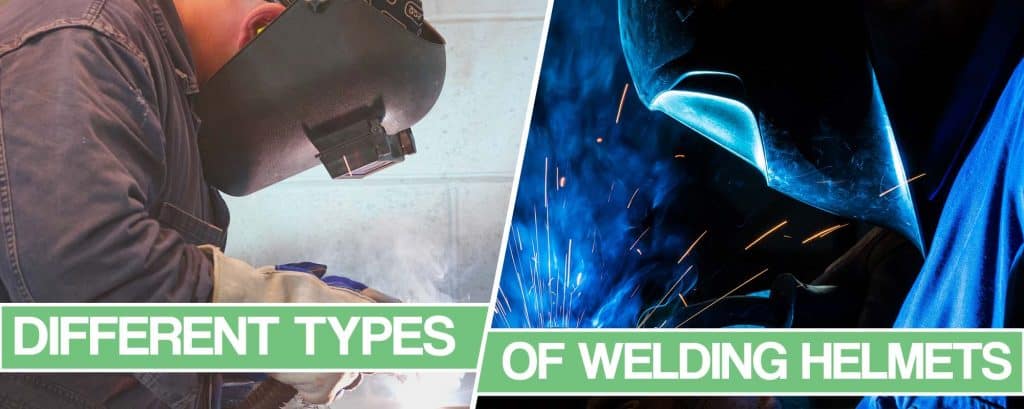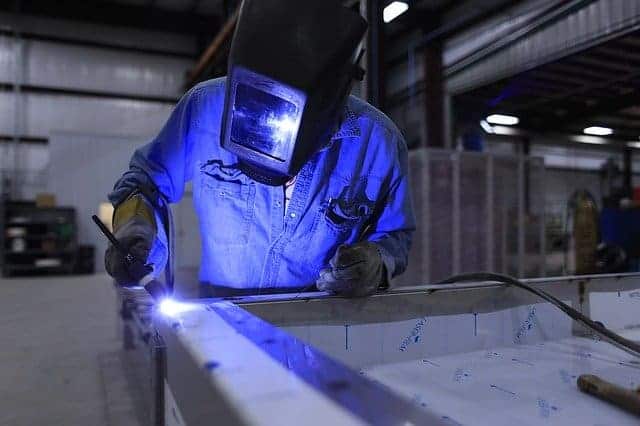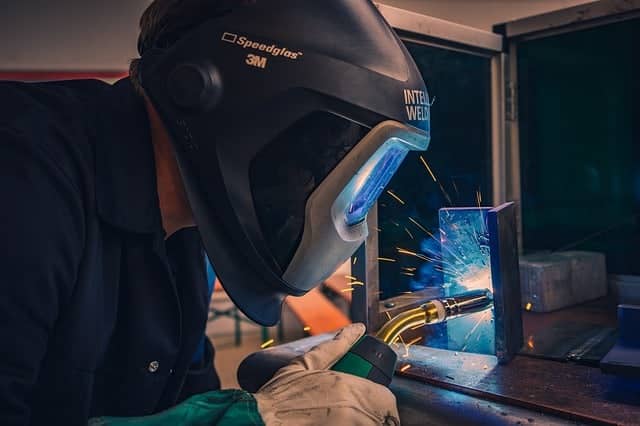Thinking about buying a welding helmet but not sure which type to buy?
That’s OK, they can seem pretty confusing at first but in reality, the choices are quite straightforward. Of course, the budget will play a part in your purchasing decision.

But it’s best to understand the way welding helmets work so that you can then buy one to suit the way that you intend to weld.
So, let’s take a quick look at the different types and what the advantages and disadvantages of each are.
Choosing The Correct Welding Helmets
There are quite a few options when it comes to welding helmets including helmets with passive lenses or auto-darkening lenses, fixed or variable shade provision, those with inbuilt sensor technology, solar-powered helmets or battery-powered, etc.
It’s vital that you choose the right welders helmet for you because it will help ensure that your welding quality is on point and that your productivity is good.
Your welding helmets must always meet the ANSI Z87.1 – 2003 safety standards, this means that they have been tested to ensure they can withstand blows from fast-moving objects, deliver 100% UV and IR filters (no matter how you adjust the shade), and that they respond with adequate levels of shade between 23 degrees Fahrenheit and 77 degrees Fahrenheit.
Passive Welding Helmets and Lens
Passive welding helmets have lenses that are made from a single color of glass and one which does not change color. They tend to be cheaper than auto-darkening variants and are optically clearer which makes it easy to see when you weld.
Welding shades explained: the welding lens’ shade number is an explanation of the way that the lens can filter light which contains ultraviolet rays and IR rays. This is because different welding jobs require different levels of optical clarity.

This is normally provided in a range from #8 to #13. Where #8 is suitable for low amp applications and #13 for high amp use. Some types of weld helmet may also include a range for #3 to #8 which is used when grinding or cutting.
In a passive welding helmet, there is only one shade value and typically this will be #10. That means it can be used for low to medium amp values only.
When you are working to position the gun or torch – the passive helmet must be in the up position. Then the operator nods their head to drop the helmet over their eyes at the moment before they strike an arc.
Passive Welding Helmets and Lens
The big advantages of these helmets are their cost and reliability but they do have some downsides too:
- If you don’t get regular experience with the welding process or have just started using a welder helmet – it can be very challenging to get the electrode in the right spot with the welding helmet is down. This can affect weld starts and cause defects.
- Tack welding is difficult with fixed shade masks as you have to spend much of the welding process lifting the welder mask and then lowering it again
- The repetitive movement of the head to move the fixed shade welding helmet up and down can cause repetitive strain injury
- A failure to lock the welding helmet into place or a poorly timed shake of the head can cause potentially damaging arc flashes prior to the shade falling into place
Auto Darkening Welding Helmets and Lens
An auto darkening welding helmet is capable of detecting how much light is being emitted in the welding process and then adjusting the variable shade level of the lens to the right amount of protection.
Unfortunately, while an auto-darkening welding helmet is undoubtedly more efficient than fixed shade welding helmets are. I
It comes at a fairly substantial increased cost.

You can find an auto-darkening welding helmet for every level of welding experience from the profession right down to the hobbyist level. If you want to consider auto-darkening welding helmets then you need to think about.
Fixed Or Variable Shades
In auto-darkening welding, you can get a welding helmet that either darkens to a fixed shade (usually #10) or you can find one which offers variable shade control that matches the shade required by the amperage of the weld (the shade range is usually #9 – #13).
It depends on the type of welding that you are doing as to which is going to be the better auto-darkening helmet. If your type of welding regularly uses the same material and roughly the same thickness of material at the same amperage then you probably want to go for a fixed option.
However, if you don’t stick to one type of welding and move around from MIG, TIG, and stick welding and you’re working with a variety of materials then variable shade auto-darkening welding helmets are probably your best bet.
Glass Or Plastic Shades
The lenses in different auto-darkening helmets are available in glass or plastic. As you’d expect glass is generally better because plastic can distort the light and color profile that you see.
We’d recommend that you always buy the best level of protection and quality of shade you can afford because you can’t afford to replace your eyes.
Auto-darkening welding helmets are particularly useful when you are covering a wide range of welding applications in your work.
Solar Or Battery Powered Lenses
This is really a matter of personal preference if you want to buy welding helmets with a power source that is solar powered or battery powered.
Of course, if you want solar powered auto darkening welding helmets then you should consider the fact that to stay charged, you’ll need to do a lot of welding outside. Solar-powered helmets require the sun to work well.

With lithium battery auto darkening helmets – you should be cautious of their tendency to switch off when not in use. You can easily pick them up and start using them without realizing that they are off.
Though this is a bigger problem when buying used welding helmets, new battery-powered welding helmets will have a screen filter to prevent arc flash.
There are also some other things to consider:
- The lens reaction time – this is the time it takes for the lens to switch from their natural state to their correct dark shade in auto darkening helmets. Entry-level lenses tend to work at 1/3,600th of a second whereas professional lenses can go to 1/20,000th of a second. The more often you spark an arc, the more you’ll come to appreciate the difference. If you do a lot of welding at 1/3,600th of a second you may find yourself suffering from eye fatigue.
- View screen area – this is usually a matter of personal preference. Helmets come with a viewing area of between 6 sq/inches and 9 sq/inches depending on the welding process you are using. There may also be some side windows.
- How many sensors? Hobbyist auto-darkening welding shades include 2 sensors and professional helmets may have up to 4. The more sensors you have the more positions you can safely weld from. 3 is best when you have a clear line of sight but 4 is better when you have to do out-of-position work.
- Sensitivity controls. A welder helmet at intermediate or professional grade should have adjustable controls for sensitivity so that you can change the brightness that triggers a certain level of shade settings. This is very useful when TIG welding at low amperages, for example, which is often not as bright as other types of welding.
- Delay controls. Your welding helmet may also offer a delay control (that is a control that allows you to keep the shade dark for a set period after the welding stops). This is useful at high-amperages when the metal may continue to glow after welding stops or when tack welding and you’re looking for a short delay before you reposition for the following weld. The human head really isn’t meant to keep bobbing up and down in sudden movements it causes neck pain.
Frequently Asked Questions (FAQs)
What Do Weld Shade Numbers Mean?
Weld shade numbers relate to the welding helmet’s ability to provide 100 percent UV and IR protection for your eyes within a temperate range of 23 degrees Fahrenheit and 77 degrees Fahrenheit. Typically they vary from #8 to #13 for welding. With #10 being standard for a passive welding helmet. These are based on set safety standards. They may also have a separate clarity rating.
How Long Does A Welding Helmet Last?
A lot depends on how you store your welding helmet and the types of battery that you’re using. Non-replaceable battery life will last 7 years, so if you have that kind of helmet that’s its shelf-life but otherwise, they could last for a decade or more with careful use and when powered by solar energy.
Is Brazing Bad For Your Eyes?
Yes, some of the output from brazing is in the far blue/UV side of the radiation spectrum and it’s not exactly good for your eyes. You should always wear eye protection when brazing with a decent viewing size. The same is true when using plasma cutting, grind mode, and any other related welding processes.
Are There Different Types of Welding Helmets?
Yes, there are several different kinds. The main varieties of lens technology involve a fixed shade or a variable one. They may use solar power or lithium batteries. You’re best off making your decision on which to buy based on the type of welding processes that you do.
What Are Welding Helmets Called?
As you might expect they’re called welding helmets. Though you may hear them referred to as masks or shades or even as a welding hood or a lens helmet too.
Conclusion
The big choice when buying the best welding helmet model is always going to be between a passive helmet with a fixed shade or a mask with auto-darkening functionality which is either variable or fixed shade. Much of this is down to the arc brightness in the kind of welding you do.
For hobby welding, a passive helmet is often the cheapest and easiest choice but if you weld a lot then it’s worth investing the extra money in an auto-darkening option.




